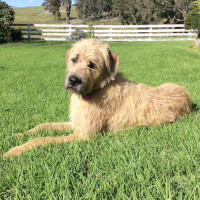Appearance of the Irish Mastiff
|
| The Irish Mastiff is a large dog, both in size and girth. This crossbreed generally measures up to 91.5 centimeters high at the shoulder and weighs over 45 kilos. The head will be large, though generally not as massive or as wide as the English Mastiff's head, and although you may see some of the wrinkles you'd find on the Mastiff's face, this trait is usually somewhat diminished by a longer muzzle, courtesy of the Irish Wolfhound. The eyes can be round or almond-shaped and are medium to dark brown in color, and the ears are small relative to the head and set high on the top of the head. Depending on which parent breed they resemble, their ears may be pulled back against the head or hang down, elongated near the cheek. Both parent breeds have a thick, downy undercoat protected by a layer of weather-resistant fur that can be straight, short and coarse, or rough and stiff. |
Temperament of the Irish Mastiff
|
| In most cases, this will be a calm, well-behaved hybrid, although it can be a little more active and clumsy during its adolescence, which usually lasts the first three years of the Irish Mastiff's life. Both parent breeds are very tolerant of children and naturally protective, however, these canines are extremely powerful animals and can get overexcited on occasion, so interactions with toddlers and young children must be carefully supervised at all times. The Irish Mastiff tends to be wary but polite with strangers, and socialization is necessary to ensure that this dog doesn't become too shy, timid or aggressive. The Irish Wolfhound, like most sighthounds, has an extremely high prey drive and in most cases neither they nor their offspring should be entirely trusting of small animals, especially fast-moving ones. They are eager to please and enjoy training, which should be started as soon as possible to get the maximum benefit from training. |
Needs and activities of the Irish Mastiff
|
| Although the Mastiff is a rather laid-back breed that generally requires less exercise than other large dogs, the Irish Wolfhound is quite active for its size, and at least 40 to 60 minutes of vigorous activity a day are needed to keep this hybrid in top condition. In addition to daily walks, these dogs are adept at a variety of activities, such as drawing and carting, coursing ability and tracking. During your dog's formative years, it's important to keep exercise sessions fairly short and not too intense to avoid damaging developing bones and joints. This can be done by interrupting exercise sessions throughout the day and ensuring that your dog doesn't jostle or jump from great heights. This crossbreed prefers the room that a larger home offers, but as they are not prone to barking unnecessarily, they may be able to adapt to apartment life if they get plenty of extra exercise in several short sessions throughout the day. Slippery surfaces should be avoided, however, to prevent joint and ligament damage. |
Maintenance of the Irish Mastiff
|
| This hybrid has a short, simple coat that makes grooming this dog quite manageable. Regular brushing with a smooth brush, soft bristle brush or curry comb is necessary to control shedding and distribute body oils, however, baths are only necessary every few months. If your Irish Mastiff inherits the folds and wrinkles characteristic of English Mastiffs, these folds should be examined and wiped to ensure that they do not contain trapped moisture or food particles, as these can lead to skin irritation and infection, possibly causing the development of a foul odor, especially around the face. Those with short, straight, hard coats will shed moderately throughout the year, while those who develop stiff coats may have very little shedding. Those with wiry coats may also require stripping, a process that can be carried out by hand or with a stripping comb. |









 English (United Kingdom)
English (United Kingdom)